-
 Artist: Utagawa Kunisada [歌川 国貞] a.k.a. Utagawa Toyokuni III [三代歌川豊国] (Japanese, 1786 – 1865). Artist signature: By the brush of the 79-year-old Toyokuni [七十九歳豊國画] (Nanajūkyū-sai Toyokuni ga). Publisher: Ebiya Rinnosuke [海老屋林之助] (Japanese, fl. c. 1832 – 1895); seal: ト/ 海老林 (to, Ebirin). Block carver: Matsushima Masakichi [松島政吉]; seal: carved by Masa [彫政] (Hori Masa). Combined date seal and kiwame censor seal: [子極] 1864 (Bunkyū 4/Genji 1). Media: Untrimmed fan print (uchiwa-e), 223 x 297 mm. Inscription in the cartouches: (R) Wakana-hime [若菜姫], Sawamura Tanosuke III [沢村田之助]; (L) Ashikaga Sanshichirō [足利三七郎], Sawamura Tosshō II [沢村訥升]. Play: Kinoene Soga Daikoku-bashira [甲子曽我大国柱], performed at the Morita theatre [森田座・守田座] (Morita-za) in 1864 (Bunkyū 4/Genji 1), 2nd month (see playbill at MFA-Boston Collection). Playwright: Muraoka Kōji II [村岡幸治]. Actors and Characters: Sawamura Tanosuke III [三代目沢村田之助] (Japanese, 1859 – 1878); other names: Shozan [曙山] (poetry name), Sawamura Yoshijirō I [初代沢村由次郎], here in the role of Princess Wakana [若菜姫] (Wakana-hime) (R). The story about Princess Wakana, Shiranui Monogatari, was written by Ryukatei Tanekazu [柳下亭種員] (Japanese, 1807 – 1858) and published as a 90-volume book of comics between 1849 and 1855. ...The tale revolves around the clash between the Kikuchi and Ōtomo clans. Princess Wakana’s father Ōtomo Sōrin [大友 宗麟] (1530 – 1587) was killed in a battle, and his spirit demanded revenge. To appease her late father's spirit, Princes Wakana acquired the power of the Earth Spider. She often appears in prints with a magic scroll, which helps her fight various enemies. Sawamura Tosshō II [二代目沢村訥升] (Japanese, 1854 – 1879); other names: Kōga [高賀] (poetry name), Sawamura Genpei II [二代目沢村源平], Sawamura Sōjūrō [澤村宗十郎], Suketakaya Takasuke IV [四代目助高屋高助], Sawamura Tosshi VI [六代目澤村訥子] (poetry name), here in the role of Ashikaga Sanshichirō [足利三七郎] (L) with a horse. According to Markus Sesko, the scene comes from the kabuki play Umakiri (馬斬り) by Tatsuoka Mansaku [辰岡万作] (17432 – 1809), which premiered in 1794. It was later assimilated into the Kabuki play Kozotte Mimasu Kuruwa no Datezome [襷廓三升伊達染], which was staged in the 1st lunar month of 1853 at the Nakamura-za. Umakiri is based on a Kyōgen play featured in Hideyoshi’s biography Taikōki [太閤記]. Its plot is that Ashikaga Sanchichirō Yoshitaka [足利三七郎義孝・義高], who is supposed to allude to Nobunaga’s son Oda Sanshichirō Nobutaka [織田三七郎信孝], attacks and kills a horse that is carrying 3,000 ryō (金三千両), money Mashiba Hisayoshi [真柴久吉] (an allusion to Hashiba Hideyoshi [羽柴秀吉]) had sent to be donated to a shrine on Mt. Kōya. The surrounding people try to catch him, but when they hear it is Yoshitaka who killed the horse, they fall to the ground and prostrate, and Yoshitaka leisurely leaves with the money. The plot is very simple, but Yoshitaka’s dashing appearance makes it very pleasing to watch. There are also prints that quote the main protagonist as Ashikaga Sanshichirō Harutaka [足利三七郎春高], and there is another title for the play, Sanzen-Ryō Kogane no Kurairi [三千両黄金蔵入] (Pocketing 3,000 ryō of gold). For reference, see also the BLOG. What these two characters are doing in one play remains a riddle. As Mr Graebner comments: "Most kabuki plays were only performed for one season (two months), and the books were lost. The playwrights have repeatedly used parts of plots from other plays, they have adopted characters, sometimes with the same or similar names. What can be found is the Kabuki Playbill (Tsuji banzuke) with cast and roles; the content is lost". Acknowledgements: Special thanks to Horst Graebner of the Kunisada Project and to Markus Sesko of The Metropolitan Museum, NY, for the analysis of the image and their invaluable contribution. For reference, see also:
Artist: Utagawa Kunisada [歌川 国貞] a.k.a. Utagawa Toyokuni III [三代歌川豊国] (Japanese, 1786 – 1865). Artist signature: By the brush of the 79-year-old Toyokuni [七十九歳豊國画] (Nanajūkyū-sai Toyokuni ga). Publisher: Ebiya Rinnosuke [海老屋林之助] (Japanese, fl. c. 1832 – 1895); seal: ト/ 海老林 (to, Ebirin). Block carver: Matsushima Masakichi [松島政吉]; seal: carved by Masa [彫政] (Hori Masa). Combined date seal and kiwame censor seal: [子極] 1864 (Bunkyū 4/Genji 1). Media: Untrimmed fan print (uchiwa-e), 223 x 297 mm. Inscription in the cartouches: (R) Wakana-hime [若菜姫], Sawamura Tanosuke III [沢村田之助]; (L) Ashikaga Sanshichirō [足利三七郎], Sawamura Tosshō II [沢村訥升]. Play: Kinoene Soga Daikoku-bashira [甲子曽我大国柱], performed at the Morita theatre [森田座・守田座] (Morita-za) in 1864 (Bunkyū 4/Genji 1), 2nd month (see playbill at MFA-Boston Collection). Playwright: Muraoka Kōji II [村岡幸治]. Actors and Characters: Sawamura Tanosuke III [三代目沢村田之助] (Japanese, 1859 – 1878); other names: Shozan [曙山] (poetry name), Sawamura Yoshijirō I [初代沢村由次郎], here in the role of Princess Wakana [若菜姫] (Wakana-hime) (R). The story about Princess Wakana, Shiranui Monogatari, was written by Ryukatei Tanekazu [柳下亭種員] (Japanese, 1807 – 1858) and published as a 90-volume book of comics between 1849 and 1855. ...The tale revolves around the clash between the Kikuchi and Ōtomo clans. Princess Wakana’s father Ōtomo Sōrin [大友 宗麟] (1530 – 1587) was killed in a battle, and his spirit demanded revenge. To appease her late father's spirit, Princes Wakana acquired the power of the Earth Spider. She often appears in prints with a magic scroll, which helps her fight various enemies. Sawamura Tosshō II [二代目沢村訥升] (Japanese, 1854 – 1879); other names: Kōga [高賀] (poetry name), Sawamura Genpei II [二代目沢村源平], Sawamura Sōjūrō [澤村宗十郎], Suketakaya Takasuke IV [四代目助高屋高助], Sawamura Tosshi VI [六代目澤村訥子] (poetry name), here in the role of Ashikaga Sanshichirō [足利三七郎] (L) with a horse. According to Markus Sesko, the scene comes from the kabuki play Umakiri (馬斬り) by Tatsuoka Mansaku [辰岡万作] (17432 – 1809), which premiered in 1794. It was later assimilated into the Kabuki play Kozotte Mimasu Kuruwa no Datezome [襷廓三升伊達染], which was staged in the 1st lunar month of 1853 at the Nakamura-za. Umakiri is based on a Kyōgen play featured in Hideyoshi’s biography Taikōki [太閤記]. Its plot is that Ashikaga Sanchichirō Yoshitaka [足利三七郎義孝・義高], who is supposed to allude to Nobunaga’s son Oda Sanshichirō Nobutaka [織田三七郎信孝], attacks and kills a horse that is carrying 3,000 ryō (金三千両), money Mashiba Hisayoshi [真柴久吉] (an allusion to Hashiba Hideyoshi [羽柴秀吉]) had sent to be donated to a shrine on Mt. Kōya. The surrounding people try to catch him, but when they hear it is Yoshitaka who killed the horse, they fall to the ground and prostrate, and Yoshitaka leisurely leaves with the money. The plot is very simple, but Yoshitaka’s dashing appearance makes it very pleasing to watch. There are also prints that quote the main protagonist as Ashikaga Sanshichirō Harutaka [足利三七郎春高], and there is another title for the play, Sanzen-Ryō Kogane no Kurairi [三千両黄金蔵入] (Pocketing 3,000 ryō of gold). For reference, see also the BLOG. What these two characters are doing in one play remains a riddle. As Mr Graebner comments: "Most kabuki plays were only performed for one season (two months), and the books were lost. The playwrights have repeatedly used parts of plots from other plays, they have adopted characters, sometimes with the same or similar names. What can be found is the Kabuki Playbill (Tsuji banzuke) with cast and roles; the content is lost". Acknowledgements: Special thanks to Horst Graebner of the Kunisada Project and to Markus Sesko of The Metropolitan Museum, NY, for the analysis of the image and their invaluable contribution. For reference, see also: -
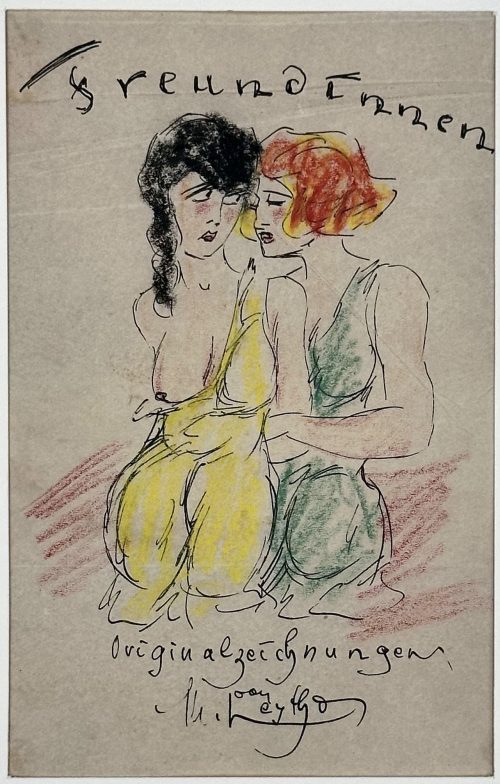 Seven pen and ink and colour crayon drawings on thin wove paper approx. 140 x 100 mm, each attached to a sheet 310 x 240 mm and mounted in a passepartout, placed in an aubergine cardboard folder 310 x 250 mm with a tan vellum spine and paper flaps inside; olive label with double border and gilt lettering to front cover "Dessins" [Drawings]. The first sheet is a title-page lettered in manuscript: Freundinnen | {vignette} | Originalzeichnungen | M. Leytho || [Girlfriends. Original drawings]. Information about the artist at www.honesterotica.com: "Mitja Leytho, almost certainly a pseudonym, is yet another mediocre yet fascinating amateur artist from the Germany of the 1920s about whom we know absolutely nothing beyond the four portfolios which bear the ‘Leytho’ signature". We shall notice that this set of drawings was produced by a talented professional, not an amateur.
Seven pen and ink and colour crayon drawings on thin wove paper approx. 140 x 100 mm, each attached to a sheet 310 x 240 mm and mounted in a passepartout, placed in an aubergine cardboard folder 310 x 250 mm with a tan vellum spine and paper flaps inside; olive label with double border and gilt lettering to front cover "Dessins" [Drawings]. The first sheet is a title-page lettered in manuscript: Freundinnen | {vignette} | Originalzeichnungen | M. Leytho || [Girlfriends. Original drawings]. Information about the artist at www.honesterotica.com: "Mitja Leytho, almost certainly a pseudonym, is yet another mediocre yet fascinating amateur artist from the Germany of the 1920s about whom we know absolutely nothing beyond the four portfolios which bear the ‘Leytho’ signature". We shall notice that this set of drawings was produced by a talented professional, not an amateur. -
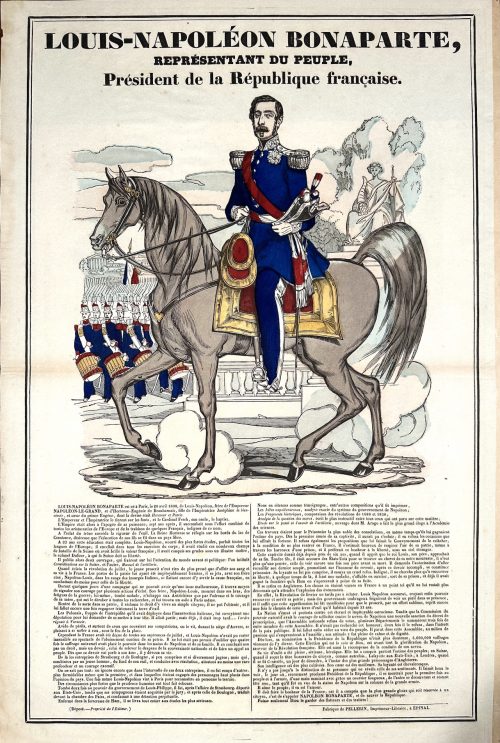 Hand-coloured woodcut poster on wove paper, 622 x 417 mm; black ink stamp “4859” to reverse, horizontal centrefold. In a double frame, top: LOUIS-NAPOLÉON BONAPARTE, | REPRÉSENTANT DU PEUPLE, | Président de la République française. Text under the image ; bottom left: (Déposé.— Propriété de l’Éditeur.); right: Fabrique de PELLERIN, Imprimeur-Libraire, à ÉPINAL. Jean Charles Pellerin (French, 1756 – 1836) – printer/publisher.
Hand-coloured woodcut poster on wove paper, 622 x 417 mm; black ink stamp “4859” to reverse, horizontal centrefold. In a double frame, top: LOUIS-NAPOLÉON BONAPARTE, | REPRÉSENTANT DU PEUPLE, | Président de la République française. Text under the image ; bottom left: (Déposé.— Propriété de l’Éditeur.); right: Fabrique de PELLERIN, Imprimeur-Libraire, à ÉPINAL. Jean Charles Pellerin (French, 1756 – 1836) – printer/publisher. -
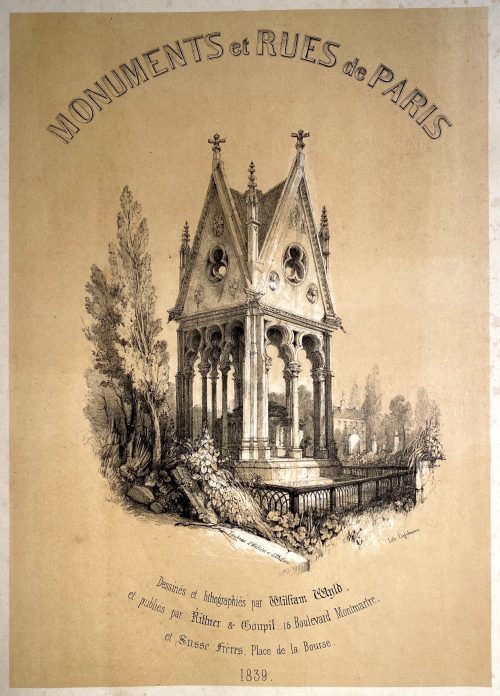 Pictorial album 55.5 x 41.0 cm, publisher’s quarter sheepskin over cloth, upper cover and flat spine lettered in gilt. Title: MONUMENTS et RUES de PARIS | Dessinés et lithographiés par William Wyld, | et publiés par Rittner & Goupil, 15 Boulevard Montmartre, | et Susse Frères, Place de la Bourse. | 1839. Collation: Title plate + 20 plates numbered from 1 to 20, printed by Godefroy Engelmann (French, 1788 – 1839) in tone lithography after drawings by William Wyld (British, 1806 – 1889). Published in Paris by Rittner & Goupil and Susse Frères in 1839. Plates: 54.8 x 39.8 cm. Contents:
Pictorial album 55.5 x 41.0 cm, publisher’s quarter sheepskin over cloth, upper cover and flat spine lettered in gilt. Title: MONUMENTS et RUES de PARIS | Dessinés et lithographiés par William Wyld, | et publiés par Rittner & Goupil, 15 Boulevard Montmartre, | et Susse Frères, Place de la Bourse. | 1839. Collation: Title plate + 20 plates numbered from 1 to 20, printed by Godefroy Engelmann (French, 1788 – 1839) in tone lithography after drawings by William Wyld (British, 1806 – 1889). Published in Paris by Rittner & Goupil and Susse Frères in 1839. Plates: 54.8 x 39.8 cm. Contents:Title page: Tombeau d'Heloïse et d'Abélard
- Le Pont Neuf
- L'église de la Madeleine
- La Porte St. Martin
- Palais des Tuileries
- Pont des Saints-Pères
- Hôtel de Ville
- Marché des Innocents
- Palais Royal
- Boulevard des Italiens
- Rue de la Paix
- Bourse et Tribunal de Commerce
- Porte St. Denis
- Pont Royal
- Place de la Concorde
- Paris from Père Lachaise
- Notre-Dame
- Jardin des Tuileries with Arc de Triomphe in the Distance
- Panthéon
- Chambre des députés
- Arc de Triomphe de l'Étoile
-
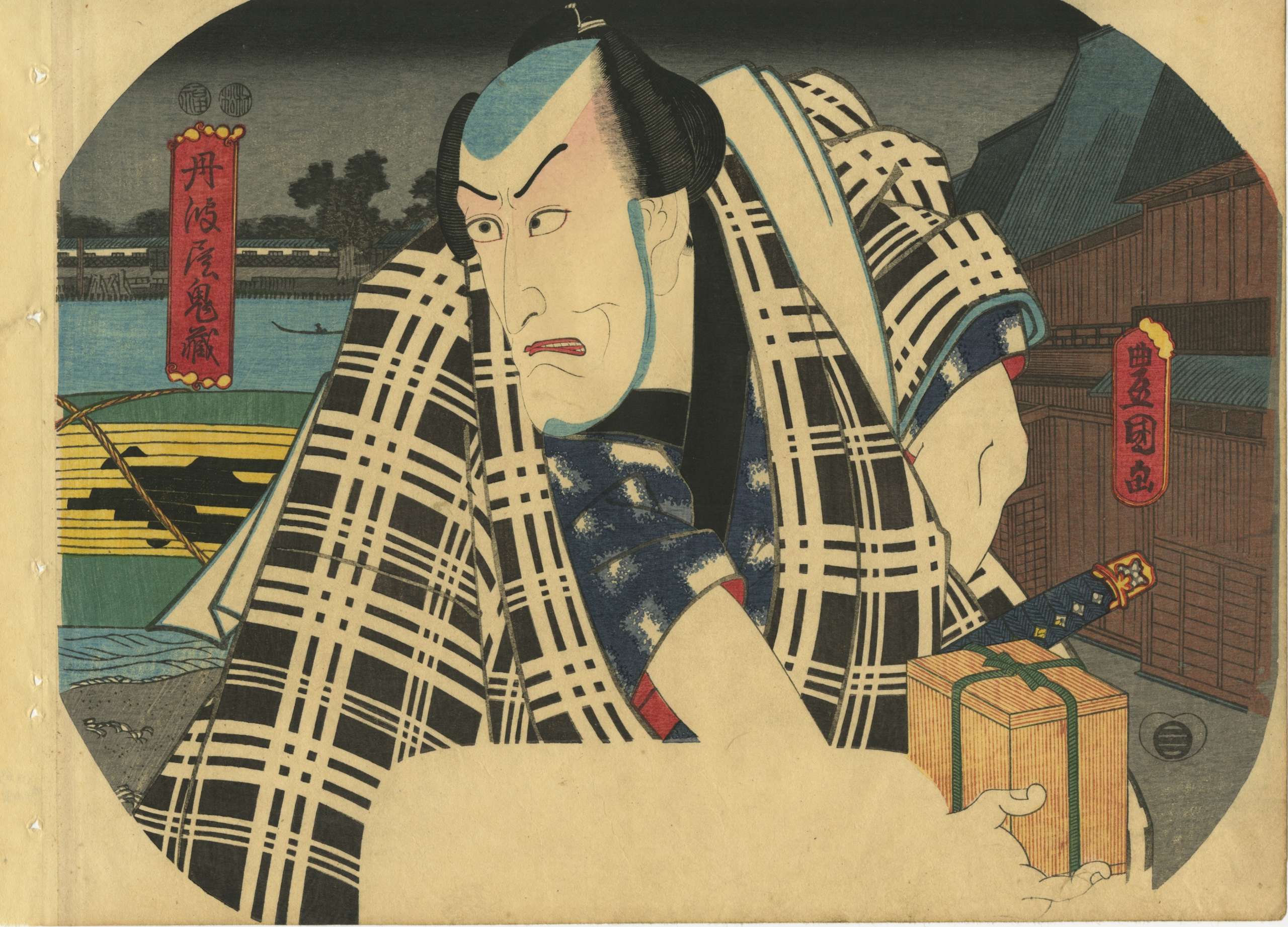 Artist: Utagawa Kunisada [歌川 国貞] a.k.a. Utagawa Toyokuni III [三代歌川豊国] (Japanese, 1786 – 1865). Signed: Toyokuni ga [豊国 画] in a red toshidama cartouche. Actor: Ichikawa Danjūrō VII 市川団十郎 (Japanese, 1791 – 1859); other names: Ichikawa Ebizō V, Ichikawa Hakuen II, Ichikawa Shinnosuke I. Character: Tanbaya Onizo [丹波屋鬼蔵] Play: Koi Bikyaku Yamato Orai [恋飛脚大和往来] Performance: Kawarasaki Theatre [河原崎座] in the 2nd month of 1851. Double nanushi censor seals: Fuku & Muramatsu, from 3rd month of Kaei 2 to 11th month of Kaei 4 (1849-51). Another fan print from the pair SVJP-0212-2.2016: Sawamura Chōjūrō V as Kameya Chubei.
Artist: Utagawa Kunisada [歌川 国貞] a.k.a. Utagawa Toyokuni III [三代歌川豊国] (Japanese, 1786 – 1865). Signed: Toyokuni ga [豊国 画] in a red toshidama cartouche. Actor: Ichikawa Danjūrō VII 市川団十郎 (Japanese, 1791 – 1859); other names: Ichikawa Ebizō V, Ichikawa Hakuen II, Ichikawa Shinnosuke I. Character: Tanbaya Onizo [丹波屋鬼蔵] Play: Koi Bikyaku Yamato Orai [恋飛脚大和往来] Performance: Kawarasaki Theatre [河原崎座] in the 2nd month of 1851. Double nanushi censor seals: Fuku & Muramatsu, from 3rd month of Kaei 2 to 11th month of Kaei 4 (1849-51). Another fan print from the pair SVJP-0212-2.2016: Sawamura Chōjūrō V as Kameya Chubei.
-
 Kitagawa Utamaro. Illustration from the book Ehon koi no Onamaki. Cited at Hayashi Yoshikazu's 20-volume set Edo makura-e shi shusei: Kitagawa Utamaro. Size: Chuban (25.5 x 18.5 cm), two book pages glued together.
Kitagawa Utamaro. Illustration from the book Ehon koi no Onamaki. Cited at Hayashi Yoshikazu's 20-volume set Edo makura-e shi shusei: Kitagawa Utamaro. Size: Chuban (25.5 x 18.5 cm), two book pages glued together. -
 Le Petit Chaperon rouge (Little Red Riding Hood), three wood engravings by Gustave Doré, 1864: "En passant dans un bois elle rencontra compère le Loup"; "Le Chaperon rouge fut bien étonné de voir comment sa grand'mère était faite en son déshabillé"; "Cela n'empêche pas qu'avec ses gran dents il avait mangé une bonne grand'mère". Engraved by Adolphe Pannemaker. Le Petit Poucet (Little Thumb), one wood engraving by Gustave Doré, 1864: "Une bonne femme vint leur ouvrir". Engraved by Héliodore-Joseph Pisan. La Belle au bois dormant (Sleeping Beauty), one wood engraving by Gustave Doré, 1864: "Il marcha vers le château qu'il voyait au bout d'une grande avenue où il entra". Engraved by Héliodore-Joseph Pisan. Medium: Paper; Wood engraving. Illustrations for P.-J. Hetzel's edition of Perrault's Fairy Tales (Les Contes de Perrault) by Gustave Doré published in 1864. Size: frame: 428 x 302 mm; sheet: 280 x 231 mm; image: 194 x 244 mm.
Le Petit Chaperon rouge (Little Red Riding Hood), three wood engravings by Gustave Doré, 1864: "En passant dans un bois elle rencontra compère le Loup"; "Le Chaperon rouge fut bien étonné de voir comment sa grand'mère était faite en son déshabillé"; "Cela n'empêche pas qu'avec ses gran dents il avait mangé une bonne grand'mère". Engraved by Adolphe Pannemaker. Le Petit Poucet (Little Thumb), one wood engraving by Gustave Doré, 1864: "Une bonne femme vint leur ouvrir". Engraved by Héliodore-Joseph Pisan. La Belle au bois dormant (Sleeping Beauty), one wood engraving by Gustave Doré, 1864: "Il marcha vers le château qu'il voyait au bout d'une grande avenue où il entra". Engraved by Héliodore-Joseph Pisan. Medium: Paper; Wood engraving. Illustrations for P.-J. Hetzel's edition of Perrault's Fairy Tales (Les Contes de Perrault) by Gustave Doré published in 1864. Size: frame: 428 x 302 mm; sheet: 280 x 231 mm; image: 194 x 244 mm. -
 Artist: Utagawa Kuniyoshi [歌川 國芳] (Japanese, 1798 – 1861). Publisher: Ibaya Senzaburō [伊場屋仙三郎] (Japanese, c. 1815 – 1869). Published in c. 1845 (no seal). Possibly, from the "Untitled series of beauties reflected in mirrors", see Kunisada Project. However, this print does not have the seal of the censor Tanaka [田中].
Artist: Utagawa Kuniyoshi [歌川 國芳] (Japanese, 1798 – 1861). Publisher: Ibaya Senzaburō [伊場屋仙三郎] (Japanese, c. 1815 – 1869). Published in c. 1845 (no seal). Possibly, from the "Untitled series of beauties reflected in mirrors", see Kunisada Project. However, this print does not have the seal of the censor Tanaka [田中]. -
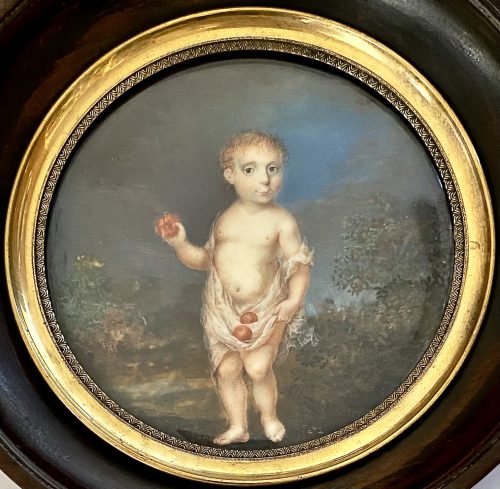 Round portrait of a little girl (22-month-old) with bright black eyes and red hair, draped in a semi-transparent shirt which leaves her chest and stomach bare, keeping a red apple in her right hand and two others lying in the fold of her clothes, standing against a dark natural background: bushes, leaves, an apple tree, blue skies, clouds, etc. Oil on metal; in an ormolu frame, in a wooden frame. Diameter without frames 8 cm, with frames – 12.6 cm. Sitter: Courtois, Fortunée-Florentine Elisabeth (French, August 23, 1800 г. – after 1878). Inscription (handwriting, nut ink): Fortunée, Florentine Elisabeth | Courtois a 22 mois. | née 5e fructidor an 8 || Attributed to Lié Louis Périn-Salbreux (French, 1753 – 1817). Fortunée-Florentine Elisabeth Courtois is a mother of Maurice Joly (French, 1829 – 1878). See also in this collection: blog, LIB-0460, blog, LIB-1038.2016, and Une Épave de l’Ancien Bateau by Tout-Paris. A Lost Article by Proust? The portrait was sold at Drouot (Paris) in 2020 with the following description: "École FRANÇAISE de la fin du XVIIIe siècle Fortunée Florentine Courtois enfant en chemise, en pied dans la nature, tenant trois pommes. Miniature sur ivoire, identifiée au revers : « Florentine Fortunée Elisabeth / Courtois à 22 mois / le 5e ( ?) Fructidor an VIII » [août 1800]; Diam. à vue : 7 cm; Cadre rond en bois tourné et noirci. Florentine Courtois, fille d’André et d’Elisabeth Corbara, épousa vers 1818 Lambert Philippe Joly, conseiller général du Jura, avocat ; leur fils Maurice Joly, avocat, fut ministre de la Justice du gouvernement provisoire en 1870 et grand maître du Grand Orient de France". Maurice Joly was a lawyer, but nothing else in his description given by Drouot is true. From this inscription, we learned that Fortunée-Florentine Elisabeth Courtois was born on August 23, 1800. We were unable to verify this from any other source. From Morice Joly autobiography (Maurice Joly, son passé, son programme par lui-même. — Paris, Lacroix, Verbœckoven et Ce, 1870) we know that she was born in Bastia and that her father, Laurent Courtois (in some sources André François Désiré Courtois, born c. 1771), was a treasurer of Corsican troops under Napoleon Bonapart. Her mother was Elisabeth Marie-Grâcieuse Corbara (born c. 1750).
Round portrait of a little girl (22-month-old) with bright black eyes and red hair, draped in a semi-transparent shirt which leaves her chest and stomach bare, keeping a red apple in her right hand and two others lying in the fold of her clothes, standing against a dark natural background: bushes, leaves, an apple tree, blue skies, clouds, etc. Oil on metal; in an ormolu frame, in a wooden frame. Diameter without frames 8 cm, with frames – 12.6 cm. Sitter: Courtois, Fortunée-Florentine Elisabeth (French, August 23, 1800 г. – after 1878). Inscription (handwriting, nut ink): Fortunée, Florentine Elisabeth | Courtois a 22 mois. | née 5e fructidor an 8 || Attributed to Lié Louis Périn-Salbreux (French, 1753 – 1817). Fortunée-Florentine Elisabeth Courtois is a mother of Maurice Joly (French, 1829 – 1878). See also in this collection: blog, LIB-0460, blog, LIB-1038.2016, and Une Épave de l’Ancien Bateau by Tout-Paris. A Lost Article by Proust? The portrait was sold at Drouot (Paris) in 2020 with the following description: "École FRANÇAISE de la fin du XVIIIe siècle Fortunée Florentine Courtois enfant en chemise, en pied dans la nature, tenant trois pommes. Miniature sur ivoire, identifiée au revers : « Florentine Fortunée Elisabeth / Courtois à 22 mois / le 5e ( ?) Fructidor an VIII » [août 1800]; Diam. à vue : 7 cm; Cadre rond en bois tourné et noirci. Florentine Courtois, fille d’André et d’Elisabeth Corbara, épousa vers 1818 Lambert Philippe Joly, conseiller général du Jura, avocat ; leur fils Maurice Joly, avocat, fut ministre de la Justice du gouvernement provisoire en 1870 et grand maître du Grand Orient de France". Maurice Joly was a lawyer, but nothing else in his description given by Drouot is true. From this inscription, we learned that Fortunée-Florentine Elisabeth Courtois was born on August 23, 1800. We were unable to verify this from any other source. From Morice Joly autobiography (Maurice Joly, son passé, son programme par lui-même. — Paris, Lacroix, Verbœckoven et Ce, 1870) we know that she was born in Bastia and that her father, Laurent Courtois (in some sources André François Désiré Courtois, born c. 1771), was a treasurer of Corsican troops under Napoleon Bonapart. Her mother was Elisabeth Marie-Grâcieuse Corbara (born c. 1750). -
 One of 64 wood engravings by Robert Dill after Joseph Kuhn-Régnier (French, 1873 – 1940), stencil-coloured (au pochoir technique) by Ateliers Jacomet in Paris for the 4-volume edition of Littré’s “Œuvres complètes d'Hippocrate” by Javal & Bourdeaux in 1932-34. The edition was limited to 2,335 numbered copies, 2,000 of them on Vélin teinté du Marais paper., numbered from 336 to 2,335. Contributors: Joseph Kuhn-Régnier (French, 1873 – 1940) – artist. Robert Dill – engraver. Atelier Jacomet (Paris); Daniel Jacomet (French, 1894 – 1966) – printer. Les éditions Javal & Bourdeaux (Paris) – publisher. Émile Littré (French, 1801 – 1881) – translator/ editor. Hippocrates (Greek, c. 460 – c. 370 BC) – author.
One of 64 wood engravings by Robert Dill after Joseph Kuhn-Régnier (French, 1873 – 1940), stencil-coloured (au pochoir technique) by Ateliers Jacomet in Paris for the 4-volume edition of Littré’s “Œuvres complètes d'Hippocrate” by Javal & Bourdeaux in 1932-34. The edition was limited to 2,335 numbered copies, 2,000 of them on Vélin teinté du Marais paper., numbered from 336 to 2,335. Contributors: Joseph Kuhn-Régnier (French, 1873 – 1940) – artist. Robert Dill – engraver. Atelier Jacomet (Paris); Daniel Jacomet (French, 1894 – 1966) – printer. Les éditions Javal & Bourdeaux (Paris) – publisher. Émile Littré (French, 1801 – 1881) – translator/ editor. Hippocrates (Greek, c. 460 – c. 370 BC) – author. -
 Title: Fourth lunar month [卯月] (Uzuki no zu); Series: Fashionable Twelve Months (Imayo juni-kagetsu). Another version of translation: Modern Beauties of Twelve Months. Artist: Utagawa Toyokuni I [歌川豊国] (1769–1825). Pubisher: Ibaya Senzaburō [伊場屋仙三郎] (Japanese, 1815 – 1869), seal: Dansendō [伊場仙]. Signed: Toyokuni ga and sealed with toshidama. Date-kiwame seal: Ushi (ox), Bunsei 5 (1822). Size: double-sheet uncut fan print ( aiban uchiwa-e), 219 x 295 mm.
Title: Fourth lunar month [卯月] (Uzuki no zu); Series: Fashionable Twelve Months (Imayo juni-kagetsu). Another version of translation: Modern Beauties of Twelve Months. Artist: Utagawa Toyokuni I [歌川豊国] (1769–1825). Pubisher: Ibaya Senzaburō [伊場屋仙三郎] (Japanese, 1815 – 1869), seal: Dansendō [伊場仙]. Signed: Toyokuni ga and sealed with toshidama. Date-kiwame seal: Ushi (ox), Bunsei 5 (1822). Size: double-sheet uncut fan print ( aiban uchiwa-e), 219 x 295 mm.

-
 Artist: Utagawa Kunisada [歌川 国貞] a.k.a. Utagawa Toyokuni III [三代歌川豊国] (Japanese, 1786 – 1865). Signed: Ichiyōsai Toyokuni hitsu [一陽斎豊国筆]. Inscriptions: [松竹梅] Shochikubai = pine (matsu, 松), bamboo (take, 竹), and plum (ume, 梅) – an auspicious grouping known as “The Three Friends of Winter“; [三福追] (Sanpuku tsui) – the three delights, or pleasures. Date seal and aratame censor seal: Ansei 2, 1st month (1855). Publisher: Ibaya Senzaburō [伊場屋仙三郎] (Japanese, c. 1815 – 1869). Block carver: Yokokawa Takejirō [横川竹二郎] (Japanese, fl. 1845 – 1863); seal: Hori Take [彫竹]. Kabuki actor Onoe Kikugorō V [五代目尾上菊五郎] (Onoe Baikō V, Ichimura Kakitsu IV, Ichimura Uzaemon XIII, Ichimura Kurōemon, Japanese, 1844 – 1903) giving candies to the memorial portrait of his predecessor, Ichimura Takenojō V [市村竹之丞] (Ichimura Uzaemon XII, Ichimura Kamenosuke, Ichimura Toyomatsu, Japanese, 1812 – 1851); the latter is dressed in a green robe adorned with a crest (mon) of a kōrin-style crane in a tortoiseshell (octagon), the hanging scroll border decorated with bamboo under snow; the collar of Onoe's kimono decorated with plum blossoms, another plum blossom arrangement decorates the screen behind him. Actors identified by Horst Graebner. Two fan prints from this series in Varshavsky Collection:
Artist: Utagawa Kunisada [歌川 国貞] a.k.a. Utagawa Toyokuni III [三代歌川豊国] (Japanese, 1786 – 1865). Signed: Ichiyōsai Toyokuni hitsu [一陽斎豊国筆]. Inscriptions: [松竹梅] Shochikubai = pine (matsu, 松), bamboo (take, 竹), and plum (ume, 梅) – an auspicious grouping known as “The Three Friends of Winter“; [三福追] (Sanpuku tsui) – the three delights, or pleasures. Date seal and aratame censor seal: Ansei 2, 1st month (1855). Publisher: Ibaya Senzaburō [伊場屋仙三郎] (Japanese, c. 1815 – 1869). Block carver: Yokokawa Takejirō [横川竹二郎] (Japanese, fl. 1845 – 1863); seal: Hori Take [彫竹]. Kabuki actor Onoe Kikugorō V [五代目尾上菊五郎] (Onoe Baikō V, Ichimura Kakitsu IV, Ichimura Uzaemon XIII, Ichimura Kurōemon, Japanese, 1844 – 1903) giving candies to the memorial portrait of his predecessor, Ichimura Takenojō V [市村竹之丞] (Ichimura Uzaemon XII, Ichimura Kamenosuke, Ichimura Toyomatsu, Japanese, 1812 – 1851); the latter is dressed in a green robe adorned with a crest (mon) of a kōrin-style crane in a tortoiseshell (octagon), the hanging scroll border decorated with bamboo under snow; the collar of Onoe's kimono decorated with plum blossoms, another plum blossom arrangement decorates the screen behind him. Actors identified by Horst Graebner. Two fan prints from this series in Varshavsky Collection:
SVJP-0335.2021
-
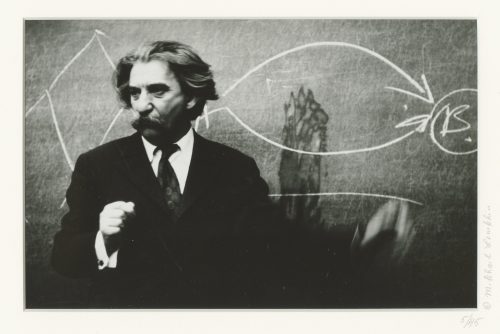 Photographic half-length portrait of academician Juri Lotman, with his head turned to the left, giving a lecture in front of a blackboard. Pencil-signed on the mat: 5/45 • ©Mikhail Lemkhin; on the back of the print: ink stamp ©MIKHAIL LEMKHIN, pencil inscription Mikhail Lemkhin 5/45; ink stamp: PHOTO BY MIKHAIL LEMKHIN | 1811–38th AVENUE | SAN FRANCISCO, CA 94122 | (415) 664-7677; Copyright statement ink stamp; on the back of the mat: pencil inscription (top) ЛОТМАН, ЮРИЙ | YURI LOTMAN, (bottom) VI. Size: mat: 35.6 x 43.1 cm; window: 15.5 x 24 cm; print: 20.2 x 25.3 cm. Limited edition of 45, of which this is № 5, signed and stamped by the artist. Sitter: Juri Lotman [Юрий Михайлович Лотман] (Estonian-Jewish, 1922 – 1993).
Photographic half-length portrait of academician Juri Lotman, with his head turned to the left, giving a lecture in front of a blackboard. Pencil-signed on the mat: 5/45 • ©Mikhail Lemkhin; on the back of the print: ink stamp ©MIKHAIL LEMKHIN, pencil inscription Mikhail Lemkhin 5/45; ink stamp: PHOTO BY MIKHAIL LEMKHIN | 1811–38th AVENUE | SAN FRANCISCO, CA 94122 | (415) 664-7677; Copyright statement ink stamp; on the back of the mat: pencil inscription (top) ЛОТМАН, ЮРИЙ | YURI LOTMAN, (bottom) VI. Size: mat: 35.6 x 43.1 cm; window: 15.5 x 24 cm; print: 20.2 x 25.3 cm. Limited edition of 45, of which this is № 5, signed and stamped by the artist. Sitter: Juri Lotman [Юрий Михайлович Лотман] (Estonian-Jewish, 1922 – 1993). -
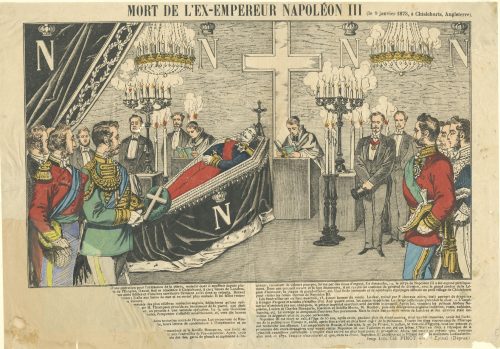 Hand-coloured woodcut on wove paper, 270 x 380 mm; attached to the sheet 303 x 442 mm with pencil ms inscription to the top left corner on the reverse: “Haye le 2-3-75”. Top: "MORT DE L'EX-EMPEREUR NAPOLÉON III (le 9 janvier 1873, à Chislehurts [sic], Angleterre)." Bottom right: "Imp. Lith. CH. PINOT, éditeur. Épinal (Dépose)". Bottom left corner of the image sheet torn and manually restored. Text partially lost, starting with « d’une opération pour l’extraction de la pierre, maladie dont’ il souffrait depuis plu-… ». See Chislehurst. Charles-François Pinot (French, 1817 – 1879) – publisher/printer.
Hand-coloured woodcut on wove paper, 270 x 380 mm; attached to the sheet 303 x 442 mm with pencil ms inscription to the top left corner on the reverse: “Haye le 2-3-75”. Top: "MORT DE L'EX-EMPEREUR NAPOLÉON III (le 9 janvier 1873, à Chislehurts [sic], Angleterre)." Bottom right: "Imp. Lith. CH. PINOT, éditeur. Épinal (Dépose)". Bottom left corner of the image sheet torn and manually restored. Text partially lost, starting with « d’une opération pour l’extraction de la pierre, maladie dont’ il souffrait depuis plu-… ». See Chislehurst. Charles-François Pinot (French, 1817 – 1879) – publisher/printer. -
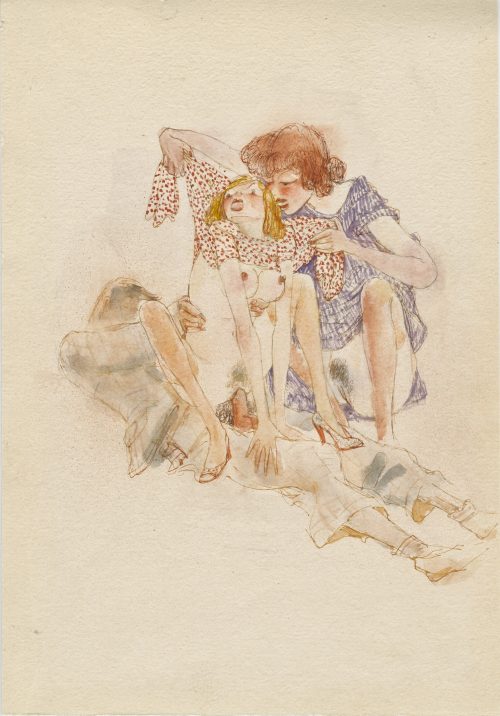 Watercolour on thick wove paper, unsigned. Attributed to Otto Rudolf Schatz (Austrian, 1900 – 1961). Size: 305 x 212 mm.
Watercolour on thick wove paper, unsigned. Attributed to Otto Rudolf Schatz (Austrian, 1900 – 1961). Size: 305 x 212 mm. -
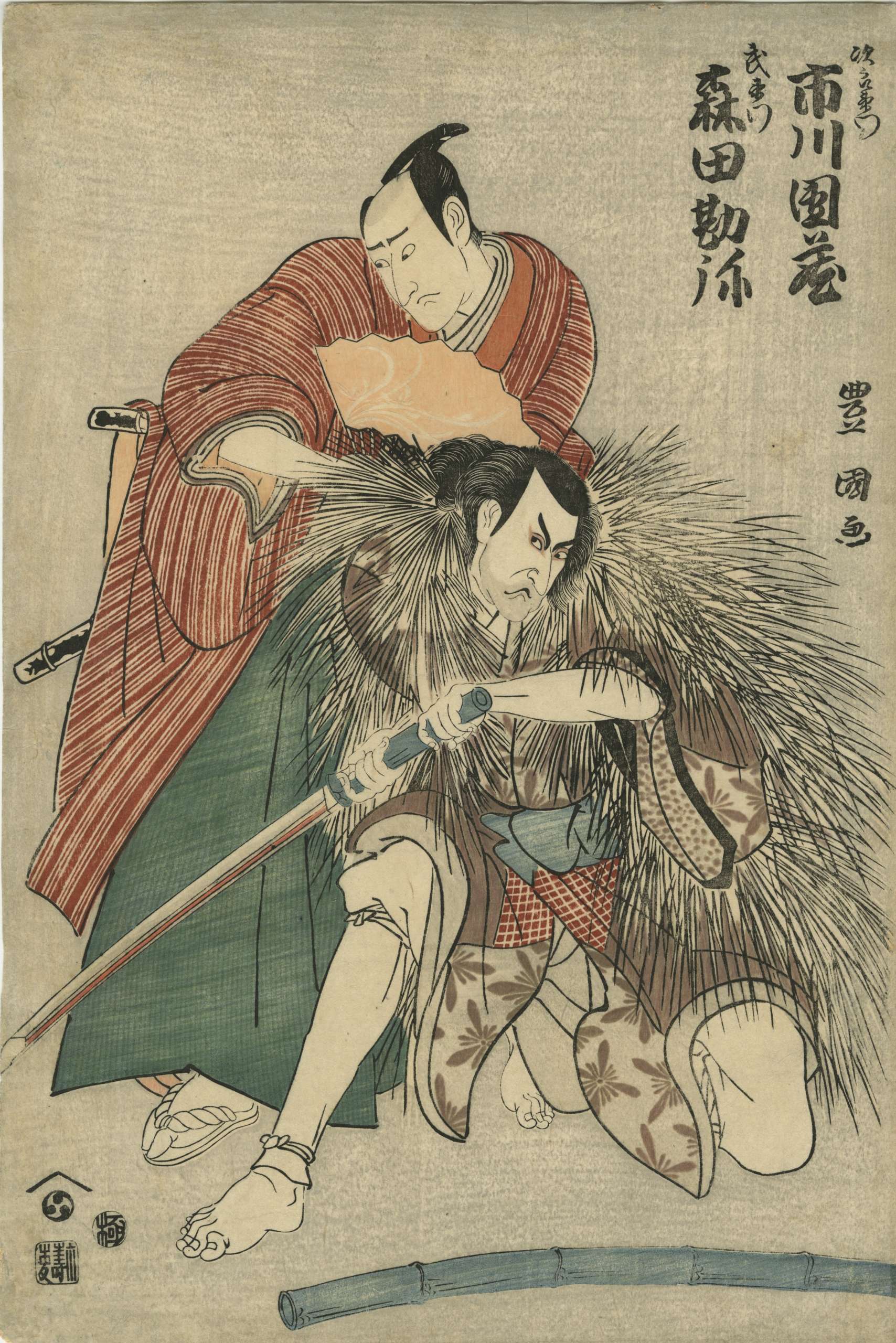 Utagawa Toyokuni (歌川豐國); 1769 – 24 February 1825. The kabuki actors Ichikawa Danzo IV as Jiroemon (in draw cape) and Morita Kanya VIII as Buemon. Play 'Oriai Tsuzure no Nishiki', performed at the Moritaza Theater in the 7th month of 1798. Publisher: Eijudo.
Utagawa Toyokuni (歌川豐國); 1769 – 24 February 1825. The kabuki actors Ichikawa Danzo IV as Jiroemon (in draw cape) and Morita Kanya VIII as Buemon. Play 'Oriai Tsuzure no Nishiki', performed at the Moritaza Theater in the 7th month of 1798. Publisher: Eijudo. -
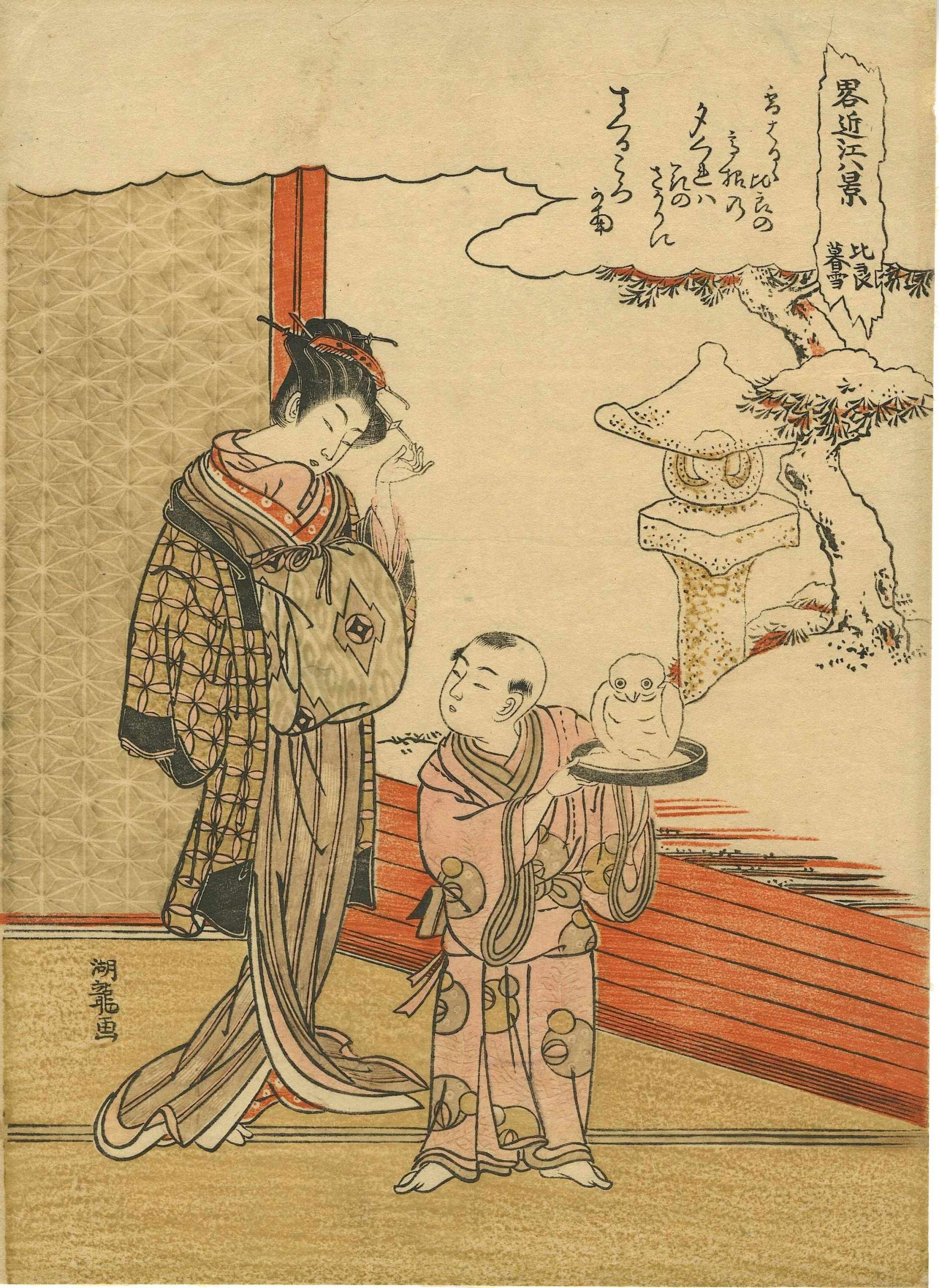 Evening Snow on Mount Hira (Hira no bosetsu), from the series Eight Views of Ōmi in Modern Guise (Ryaku Ōmi hakkei, (略近江八景). About 1773–75 (An'ei 2–4). Artist: Isoda Koryūsai (Japanese, 1735–1790) CATALOGUE RAISONNÉ: Hockley 2003, p. 202, #F-21-1 DIMENSIONS: Vertical chûban; 26 x 19.3 cm (10 1/4 x 7 5/8 in.)Signed: Koryû ga [湖竜画]
Evening Snow on Mount Hira (Hira no bosetsu), from the series Eight Views of Ōmi in Modern Guise (Ryaku Ōmi hakkei, (略近江八景). About 1773–75 (An'ei 2–4). Artist: Isoda Koryūsai (Japanese, 1735–1790) CATALOGUE RAISONNÉ: Hockley 2003, p. 202, #F-21-1 DIMENSIONS: Vertical chûban; 26 x 19.3 cm (10 1/4 x 7 5/8 in.)Signed: Koryû ga [湖竜画] -
 Artist: Utagawa Kuniyoshi [歌川 國芳] (Japanese, 1798 – 1861) Publisher: British Museum provides for the title as Enkyoku-zoroi [艶曲揃] (Set of Voluptuous Melodies) and the publisher as Sanpei. Indeed, 三平 (Sanpei) was a wholesale fan shop at the end of the Edo period. However, Andreas Marks identifies the publisher's seal as 三平 Mihei = Mikawaya Heiroku (1848-56), a member of the Fan Producing Guild (AM 11-016|325a). Block carver: Yokokawa Takejirō, seal: Carver Taki [彫竹] (Hori Take)
Artist: Utagawa Kuniyoshi [歌川 國芳] (Japanese, 1798 – 1861) Publisher: British Museum provides for the title as Enkyoku-zoroi [艶曲揃] (Set of Voluptuous Melodies) and the publisher as Sanpei. Indeed, 三平 (Sanpei) was a wholesale fan shop at the end of the Edo period. However, Andreas Marks identifies the publisher's seal as 三平 Mihei = Mikawaya Heiroku (1848-56), a member of the Fan Producing Guild (AM 11-016|325a). Block carver: Yokokawa Takejirō, seal: Carver Taki [彫竹] (Hori Take)Signed: Ichiyosai Kuniyoshi ga in a red cartouche and sealed with paulownia (kiri mon).
Date seal and double nanushi censor seals: Fuku & Muramatsu, 1853 (Kaei 6, 2nd month).
Size: Uchiwa-e (untrimmed fan print) 296 x 230 mm.

SVJP-0303.2019







